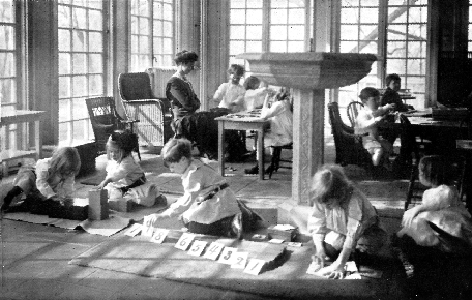A Day in the Life of a Montessori Classroom
The Glass Classroom
Seeing is believing when it comes to Montessori. It is rare to meet a person who has visited and observed a high-fidelity Montessori school that is then critical of the method. Since observation is such a core element of the work we do, we have welcomed outsiders from the very beginning to see for themselves.
In 1915 there was a World’s Fair, The Panama-Pacific International Exposition, in San Francisco. The affair stretched out over many months, took over hundreds of acres, and was visited by more than 18,000,000 people.
Dr. Maria Montessori held an exhibit at the fair, which has gone down in history as a major steppingstone to informing Americans about Montessori education. The Glass Classroom, which visitors could see into, showed the public just what went on inside a Montessori school. Visitors were astounded by what they saw.
A Day in the Life of a Primary Environment
The tradition of the Glass Classroom continues even today. Many Montessori schools have observation windows so that parents and visitors can peek inside without being noticed. All Montessori schools encourage adults to observe - window or not. We feel it is the best way to fully understand what an authentic Montessori classroom is like.
The following is a glimpse into a day in the life of a Montessori class. Details may change based on the age of children, weather, and special events.
Early morning, before the children arrive
The Guide arrives, hangs their coat, changes their shoes, and admires the beautiful classroom environment upon entering. So much love and attention to detail has been put into the creation of this space, with minor changes being made throughout the year to better serve the ever-evolving needs of the children.
The Guide may put on some relaxing music, turn on the lamps, and get to work reviewing the plans for the day. If any materials need to be prepared (or repaired) this is done. Pencils are sharpened and chairs set down. As colleagues trickle in they take a moment or two to check in with one another. Snack is prepared and the staff prepare to greet the children.
Drop-off and arrival
Family cars descend upon the campus, and children hop out of back seats with bags and coats in tow. Independently, the children make their way to their classrooms, hang their own coats, and change into their indoor shoes. Their Guide, Assistant and Aide are there to greet each child with a smile.
The children walk through the doorway, scan the room to see which friends have arrived and what work they are doing, and prepare to choose activities.
The morning work cycle
The first two and a half to three hours of each day are dedicated to the morning work cycle. This allows children to sink deeply into their work, and the flexible schedule means children will transition as they are ready and will work independently according to their own personal needs.
A three-year-old sits on a large area rug, with a work mat beneath the pink tower, which she is carefully stacking higher and higher. She carefully compares the sizes of the blocks, adjusting as needed so that they become smaller as they ascend.
Several four-year-olds sit together at a table, working in silence to create maps. One uses colored pencils to either trace or free-draw the continents. Another uses watercolor paint to shape two blue spheres on a large piece of white paper. The third, who has previously completed the other two steps, is seen painting their continents onto the painted hemispheres.
At the next table over, the Guide is sitting with a five-year-old to give an initial lesson with the Stamp Game material. This child has an affinity for math and is ready to move on to more challenging work. Today they will begin adding larger numbers.
Two friends have decided they need a break. They have been enjoying a snack together at a designated table, and as they finish, they take their dishes to the sink and wash them in a prepared soapy sink of water. After a quick rinse they leave them in the rack to dry.
The classroom is not silent by any means. There is a gentle hum, with most children working quietly. They all seem engaged in whatever they are doing - even the very youngest students. One small child is seen wandering around the room. They are not working, but they are not disturbing the work of anyone else, either. This goes on for about ten minutes or so, at which point they select an activity from the shelf and get started. They were able to move around and take the time they needed to transition, and they were trusted to make their own decisions.



